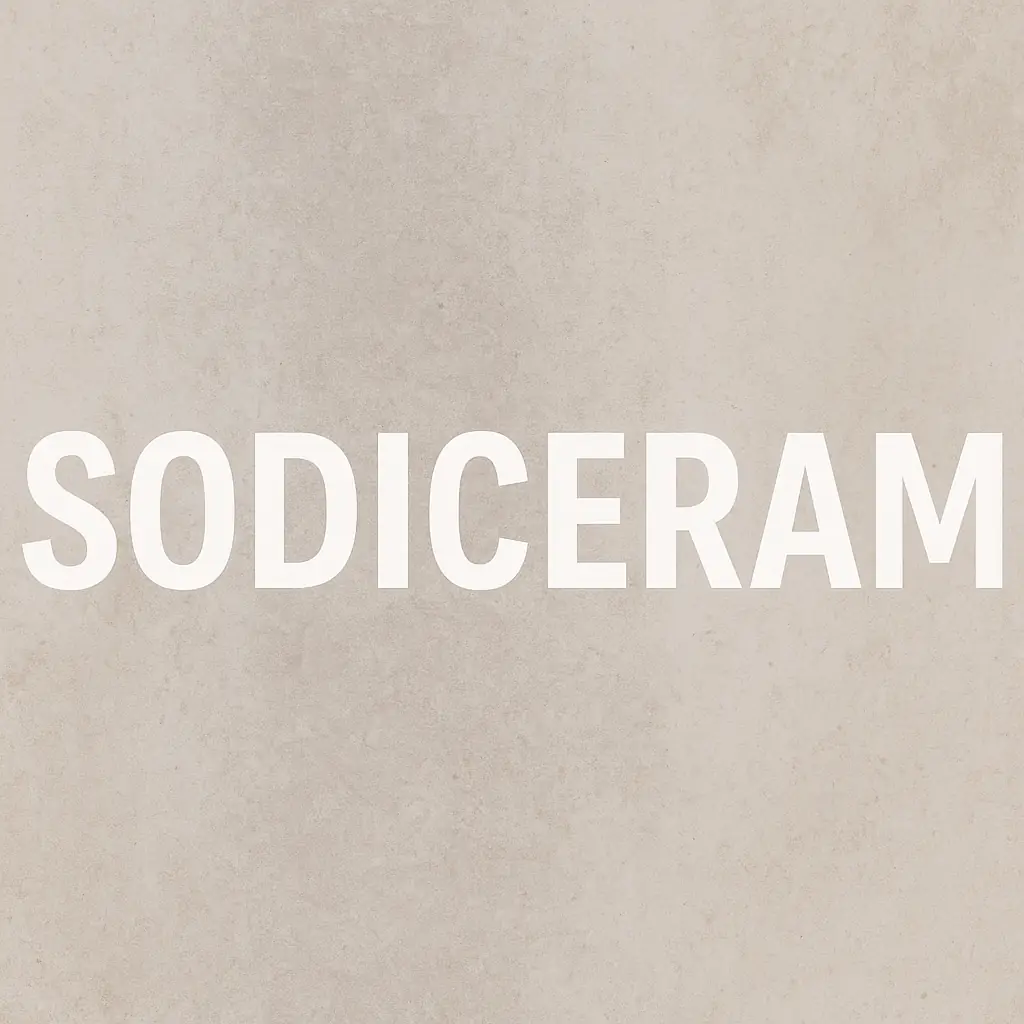A sodium infused ceramic that unites strength, style and sustainability, Sodiceram molds responses to the ever changing world of materials. In this article, we will break down the science one by one and its pros/cons.
What Is Sodiceram?
Sodiceram is a new class of advanced ceramics produced through the incorporation of sodium-containing compounds into the ceramic.
The word combines “sodi-” (from sodium) and “ceram” (for ceramic).
It is because sodium serves as a fluxing nor glass forming agent which improves densification, adequately reduces porosity and increases thermal and chemical stability.
In other words, sodiceram is designed to be an improved version of traditional cermics due to controlled sodium addition.
The Science Behind Sodiceram
Composition & Raw Materials
The typical steps of production are the following:
Blending: Blending of raw powders to ensure a homogeneous mixture.
Forming: Form the mixture (press forming, extrusion, casting).
Dry: Slow dry to prevent cracking.
Firing: The body is fired under carefully controlled schedules so that sodium compounds flux, there is glass phase development and densification.
Densification can be obtained at lower firing temperatures than for traditional ceramics due to the presence of sodium in the ceramic body.
Glazing or surface finishing can follow post-firing, and sodiceram is compatible with all types of glazed (matt, gloss, satin) – due to better adhesion of the glaze ensured by sodium chemistry.
Processing & Firing
The methodology of production in general includes the following steps:
Blending: The raw powders are blended to a homogeneous mixture.
Forming: The mixture is brought into form (pressing, extrusion, casting).
Drying: Slow drying to prevent cracking.
Heating: The body is dried out under controlled conditions where sodium compount fluxes, glass phases are formed and densification occurs.
Sodium imparts densification to the ceramic body at a temperature which is somewhat lower than that applicable to standard ceramics.
Firing post-treatment, glazing or surface finishing may be performed and sodiceram is compatible with all types of glazes (matt, glazed, textured) due to the enhanced glaze adhesion coming from sodium chemistry.
Microstructure & Properties
The infusion of sodium gives sodiceram a microstructure with:
- Lower residual porosity (often ≤ 0.5 %)
- Better densification and glassy phase filling voids
- Controlled coefficient of thermal expansion
- Improved adhesion between grains and glassy phases
These structural benefits translate to improved mechanical, thermal, and chemical performance.
Key Advantages of Sodiceram
Here are the main benefits that make sodiceram attractive:
1. Mechanical Strength & Durability
Sodiceram presents higher bending and compressive strength opposed to most ceramics up till now.
It also resists chipping and cracking better in a lot of ways.
2. Thermal Shock & Stability
Sodium plays a role in fluxing and the control of glass phase, so sodiceram is more heat-shock-resistant than ordinary ceramics.
This latter property can be very valuable in environments where rapid heating or cooling may occur.
3. Chemical & Stain Resistance
Its low porosity effectively blocks stains, acids, alkalis, oils, and detergents from penetrating the surface.
It can be very useful for kitchens, washrooms, labs and industrial environment.
4. Aesthetic Flexibility & Finish Quality
Since it is a sodium sensitive matrix, sodiceram supports varied surface finishes – matte, polished, textured and even digitally printed patterns are realised because of the good glaze compatibility.
Designers can replicate stone, marble, wood grain and other designs in addition to abstract patterns without sacrificing performance.
5. Sustainability & Energy Efficiency
Since sodiceram can sinter at slightly lower firing temperatures, the energy consumption is also decreased.
It has long life, so you will not replace it often. Some sources state up to ~30% energy savings in production from vs conventional ceramics.
Moreover, some formulations could have end-of-life recycling and re-use opportunities.
Limitations & Challenges
No material is without constraints. For sodiceram:
- Cost and complexity: Manufacturing is more complex due to sodium control and process precision.
- Sodium balance trade-offs: Excess sodium may cause warping, mismatch with glaze, or instabilities.
- Brittleness: Like all ceramics, even sodiceram is brittle. Sudden point loads may lead to fractures.
- Market maturity & adoption: While promising, widespread use is newer. Long-term field data is still emerging.
- Compatibility issues: Matching expansion rates, substrate constraints, or adhesives may pose challenges in installations.
Still, with proper engineering and quality control, these limitations can be mitigated.
Applications & Use Cases of Sodiceram
Because of its hybrid strengths, sodiceram fits well in many sectors.
Residential & Commercial Interiors
- Flooring and wall tiles
- Countertops and backsplashes
- Bathroom & kitchen surfaces
- Decorative panels
Here, its stain resistance, beauty, and durability shine.
Architectural Façades & Cladding
Sodiceram can be used as exterior cladding, ventilated façades, curtain walls, and decorative façades. It withstands weather, UV, frost, and thermal variations.
Its lighter weight compared to natural stone helps in high-rise or large constructions.
Industrial & Technical Applications
- Furnace linings and heat-resistant components
- Electrical insulators and substrates
- Chemical plant linings or surfaces
- Automotive thermal parts
Its thermal stability and chemical resistance are valuable in harsh environments.
Art & Design
Sodiceram allows for digital printing, sculptural forms, custom textures, and small runs. Artists can explore new aesthetics with durability.
How to Specify & Install Sodiceram
Selection Criteria
Designers and engineers should consider:
- Thickness and size
- Surface finish and slip rating
- Mechanical load requirements
- Coefficient of thermal expansion
- Compatibility with adhesives and substrate
Substrate & Adhesive Compatibility
- Use stable, flat substrates (e.g. concrete, cement board)
- Select flexible adhesives (cementitious, polymer-modified) to allow for thermal movement
- Provide adequate joint spacing to absorb expansion and contraction
Installation Considerations
- Ensure full adhesive coverage (≥ 90 %) especially for large tiles
- Use proper grouts (e.g. epoxy or high performance) in harsh chemical settings
- Allow adequate curing time
- Protect surfaces during construction
Maintenance & Repair
- Routine cleaning with neutral detergents
- For small chips, use color-matched epoxy fillers
- For cracked pieces, careful removal and replacement is necessary
- No need for sealing in many cases due to low porosity
Quality Control & Testing
- Flatness, edge tolerance, color consistency
- Adhesive bond strength
- Porosity and absorption testing
- Thermal shock and mechanical stress trials
Sodiceram vs. Traditional Ceramics & Alternatives
Traditional Ceramics / Porcelain
- Higher porosity, more prone to staining
- Less tolerance for thermal shock
- Often heavier and with less design flexibility
Sodiceram offers stronger performance in many dimensions.
Vitrified & Engineered Stone
Vitrified tiles and engineered stones are similar competitors, but sodiceram may even exceed them in sodium-activating densification and chemical resistance on a few compositions.
Advanced Ceramics & Nanoceramics
These are typically higher cost and specialized for end uses (eg aerospace). Sodiceram manages a better compromise among cost, behavior and design.
Thus, sodiceram stands between standard and ultra-performing technical ceramics.
Future Trends & Research Directions
The development of sodiceram is ongoing, with these possible paths:
- Smart ceramics integration: Embedding sensors or heating elements
- Improved recyclability and closed-loop manufacturing
- Better glazing technologies and surface treatments
- Localized production near resources to reduce carbon footprint
- Wider standardization and certifications to boost adoption
As research matures, sodiceram might become mainstream in many industries.
Frequently Asked Questions
1. What is sodiceram used for?
It is used in flooring, wall tiles, countertops, façades, industrial components, and decorative structures.
2. How does sodiceram differ from conventional ceramics?
It has lower porosity, higher density, better chemical and thermal resistance, and enhanced mechanical properties due to sodium infusion.
3. Can sodiceram be used outdoors?
Yes. Its frost resistance, UV stability, and thermal shock tolerance make it suitable for façades and exterior surfaces.
4. Does sodiceram resist acids, alkalis, or chemicals?
Yes. Its low porosity helps resist many household and industrial chemicals without damage.
5. Is sodiceram expensive?
Upfront costs may be higher than basic ceramics, due to complex processing. But long life and lower maintenance offset costs over time.
6. Can sodiceram be recycled?
In many formulations, yes. It can be crushed and reused, or in some cases re-fired. Research continues in recycling efficiency.
7. Is sodiceram brittle?
Like all ceramics, it is brittle under sharp point loads. But its improved toughness and controlled design reduce risk of failure in typical conditions.



